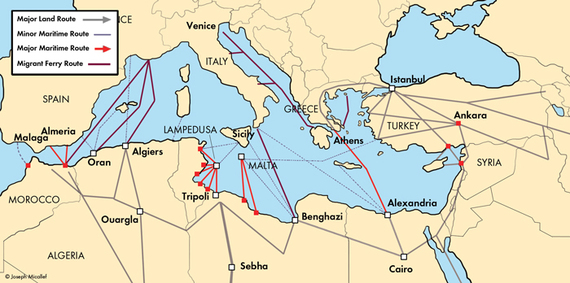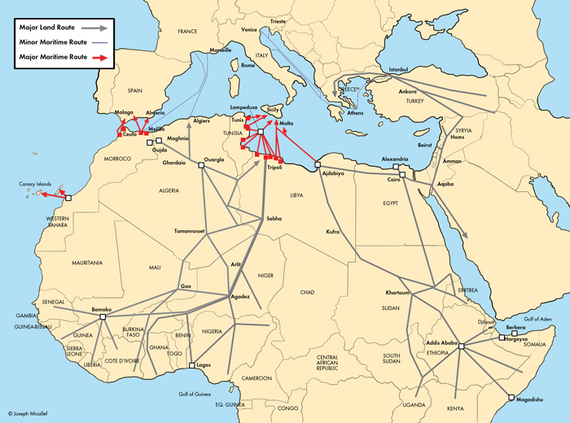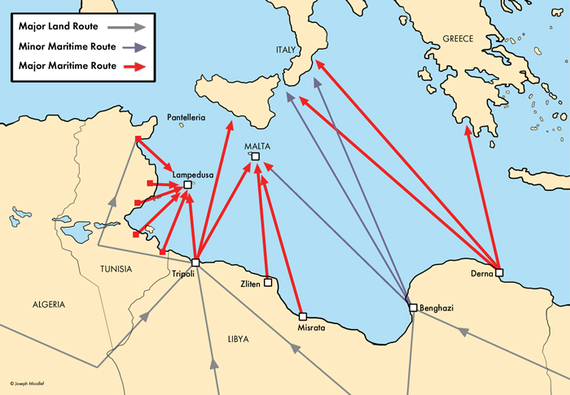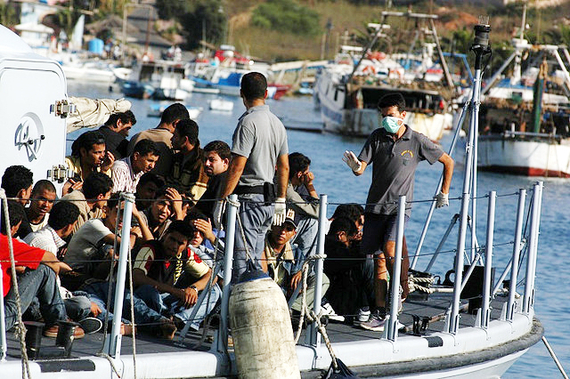At the center of the Mediterranean refugee crisis is a simple truth, large numbers of people from Africa and the Middle East are seeking to make a new life for themselves in Europe. Since they have arrived without invitation their proposed immigration is technically "illegal." These people are described as "refugees," and lately, given their strategy to enter Europe by crossing the Mediterranean, as "Mediterranean refugees," even though many of them have only tenuous links to the Mediterranean Sea.
Some in fact have been displaced by war and violence and forced to abandon their homes. Others are simply fleeing poverty and hopelessness for the promise of a better life in Europe. The EU's generous social welfare programs are a virtual guarantee of a better life than the one they left behind. The magnitude of the crisis has been underscored by the rising death toll that has accompanied the growing number of refugees attempting the dangerous crossing.
In 2014, approximately 650,000 people sought political asylum in Europe. Approximately 35 percent, about 220,000, of them had been picked up by a combination of military patrol ships and various private and commercial craft as they attempted to cross the Mediterranean Sea. Most chose to cross in the relatively narrow central Mediterranean, where the North African shore is only 100 miles (Tunis to Trapani) to 300 miles (Tripoli to Sicily) from Europe and which is dotted with a number of island "safe havens," Pantelleria, Lampedusa and Malta among the better known ones.
In the short term, this "Mediterranean Refugee Crisis" has been facilitated by the civil wars in Libya and Syria and the resulting breakdown of governmental authority, the virtual abandonment of border controls and the concomitant rise of criminal gangs and jihadist groups that have stepped into the power vacuum for their own ends.
In the eastern Mediterranean, where roughly 20 percent of the refugees have originated, the bulk have come from Syria; victims of the four year long civil war. Most of the refugees have ended up in camps in Turkey, Lebanon and Jordan. These three countries are hosting over 3.6 million Syrian refugees. An additional 500,000 refugees are scattered across a broad range of other countries, with roughly three quarters of that number in Iraq and Egypt. An additional six million refugees remain displaced within Syria itself. Only a relatively small portion of these refugees have attempted the journey to Europe, most of them crossing the eastern Mediterranean to either Cyprus or Greece.
In the central Mediterranean, where the bulk, about 80 percent, of the refugees are coming, Libya and to a lesser extent Egypt and Tunisia, has become the launching point for a pool of refugees being drawn from a broad area of central and North Africa. From Somalia and Eritrea on the Red Sea across the Sahel to the Gulf of Guinea, scores of Africans are making their way to North Africa's Mediterranean shore and the prospect of a European life.
The smuggling operation consists of three distinct segments: the journey to the Mediterranean coast, the journey across the Mediterranean Sea and the journey across Europe. The organization of the various components is not entirely clear. It is unlikely that any one organization controls all three elements. More likely, there are informal links between various organizations with groups of refugees passed from one organization to another, much the same way that various criminal organizations work together in the transport of narcotics around the world.
According to John Hooper, the Economist's Italy correspondent, Italian authorities believe that the human trafficking in Libya is controlled by four separate organizations. Virtually no additional details have been released pending further investigations by Italian police. The relationship between the Libyan based smuggling rings and their European based counterparts is unclear as is the extent of their cooperation. In addition to the "main organizations" there are a host of "free lancers" that are also involved in smuggling refugees.
The costs for each segment of the journey can run from as little as 500 dollars to over 3,000 dollars. Costs are assessed both on the basis of an ability to pay as well as by the relative comfort of the journey. On the larger boats across the Mediterranean, the lowest paying customers are usually locked in the hold while top paying customers at least get to be topside. Even among human smugglers there is a distinction between first class and steerage, relatively speaking. In total, it may cost as little as a few thousand dollars or as much as 10,000 dollars a head to make the journey.
Most of the refugees lack sufficient funds to pay the cost of transport. A significant portion of the funds that oil these smuggling operations originate in Europe among friends and relatives of the refugees. Hawalas, the informal word of mouth banking networks that have operated in the Middle East for centuries, facilitate the transfer of funds. Such transfers rely on long standing personal relationships between these "bankers." There is no electronic transfer, no SWIFT codes or routing slips, no paper or computer trail for authorities to track. While the unauthorized entry by migrants into Europe is illegal, providing funds to their smugglers is not. Ironically, Europe is itself financing its own invasion by illegal immigrants.
Jihadist organizations operating in Libya are believed to be heavily involved in the human trafficking either by providing "protection" to the criminal gangs that are carrying it out or by organizing it themselves. Ansar al-Shariah, the Islamic State's affiliate in Libya, has a leading role in the smuggling of refugees into Europe. The Mediterranean portion of the illegal trafficking has been estimated to generate approximately 500 million dollars for the Libyan groups involved with it. The entire smuggling operation probably represents an activity generating in excess of a billion dollars for all of the parties concerned.
Not only has this illegal trade funded the operations of various jihadist groups but it has also provided a convenient means of potentially smuggling jihadists into Europe. Islamic State has boasted that it has smuggled over 4,000 of its supporters into Europe. Although this figure is most likely exaggerated, it is virtually certain that some number of jihadists have already entered Europe in this way. Virtually none of the refugees carry any documentation. Formal processing by immigration authorities has been hit or miss. Until quite recently, many refugees were not even finger printed by authorities.
Between April 13 and 21, it is believed that as many as 1,300 refugees perished as a result of boats sinking while making the crossing. Four of the boats that sank were in the central Mediterranean while the fifth was off Cyprus. To date, over 1,500 people have perished, a seventeen fold increase over the comparable period last year and the "Mediterranean refugee season" is just barely beginning. The deaths have raised cries of protest across Europe and mobilized a broad range of humanitarian organizations to get involved in rescue efforts.
The death toll, though tragic, misses the larger issue at stake here. By most accounts, 95 percent or more of the refugees are making it to Europe. Those figures are based only on the number of refugees being picked up by European authorities. If the number of refugees that escape detection is added in, and no one quite knows what that number is, then the percentage of refugees that survive the crossing is even higher.
Even if not a single refugee was dying during the journey, the magnitude of the problem would not be any less critical. Europe cannot continue to absorb hundreds of thousands of refugees nor can the front line Mediterranean states, from Spain to Italy, Malta and Greece continue to absorb the costs of policing Europe's southern border or the burden of dealing with the Mediterranean refugee crisis.
The death toll and the dangers and rigors of the journey are not enough to discourage migrants from making the dangerous journey. Italian authorities believe that there are half a million refugees on the southern shore of the Mediterranean ready to attempt the crossing this summer. Some estimates have placed the number as high as one million.
Moreover, the refugees entering Europe via the Mediterranean is only part of the problem. According to FRONTEX, the EU agency charged with managing Europe's border controls, "The single biggest entry route for migrants into the EU is via international airports: most of those who currently reside in the EU illegally, originally entered in possession of valid travel documents and a visa whose validity period they have since overstayed."
The EU has been powerless to deal with the crisis. In part, because there is no consensus on what issues it needs to address. The deaths of refugees on the high seas have raised a storm of protest throughout the world and has been deeply embarrassing to Europe's elected leaders.
The solution is easy enough, simply expand the number of boats on station in the central Mediterranean and deploy them closer to the North African shore. That's precisely what Italian authorities were doing before they pulled back from their forward deployments in the face of criticism from other European countries that their Mare Nostrum program, in plucking the migrants off the high seas was encouraging even more refugees to make the dangerous journey.
On Thursday, April 23, EU leaders announced the expansion of the current Triton program to intercept refugee boats. The number of ships deployed and funding would be tripled under the new proposal, restoring the deployment to levels comparable to the previous, Italian, Mare Nostrum program. In addition, the search and rescue effort would be expanded to include the maritime transit routes to Greece as well. EU leaders also announced they would seek U.N Security Council authority to seize and destroy boats being used by the smugglers.
The problem is to either prevent the refugees from coming or to determine what to do with them once they are rescued. The fact is that no one wants these people. Europe, battling record high unemployment, stagnant economies, record government deficits and the steady growth of anti-immigrant parties has no appetite to accommodate a never ending stream of refugees.
Repatriation is not always feasible. In many instances it contravenes existing EU laws and most of the time it's not certain where the refugees should or could be sent. In March, the EU floated the idea of setting up refugee camps in Tunisia and Egypt, supervised by those respective governments and financed by the EU, and repatriating the Mediterranean refugees there. The trial balloon went nowhere. While such a scheme might alleviate the problem in the short term, in the long term it would create even greater problems.
Instead various EU leaders have announced that they are launching police investigations of the criminal gangs involved in the human trafficking and that they are targeting the leaders of these organizations for police and possibly even military interventions. On the April 21, Italian authorities publically announced the arrest of a Tunisian boat captain and his first mate on charges of aggravated manslaughter as a result of the deaths of scores of refuges they were carrying illegally to Europe. Such actions may make for great headlines but they are completely ineffectual.
To begin with it is unlikely that criminal investigations of the various groups engaged in the human trafficking will yield much result. Likewise, the likelihood of any kind of military intervention in Libya, beyond, at best, a token air raid against some group's headquarters, is also highly unlikely. There is no support in Europe for any kind of military intervention in Libya and it is unlikely that any such intervention would do anything more than add to the chaos which already reigns there.
Moreover, while the various criminal and jihadist groups are certainly facilitating this human trafficking, and are profiting mightily from it, they are simply responding to the demand for such services from the hundreds of thousands of would be immigrants. Arresting the leaders of these organizations, or even eliminating these organizations all together, will not eliminate the problem in the long run. It will simply set the stage for a new group of organizations to take the lead.
All over the world millions of immigrants are on the move, looking for safety and a better life for themselves and their families. Across the Mediterranean, across the Rio Grande, the Plata and the Padma, across the Indian Ocean or the South China Sea, the journey may be different but the objective remains the same.
Mona Chalabi, writing in The Guardian, September 11, 2013, has estimated that there were 232 million immigrants worldwide as of 2013. Joseph Chamie, the former Director of the U.N. Population Department, believes at least 50 million of those immigrants are "illegal" or "undocumented." Other estimates have placed the number as high as 100 million. In most developing countries, illegal immigrants comprise between 1 and 4 percent of the population. The Department of Homeland Security has estimated the number of "undocumented" immigrants in the United States at around 12 million people, or about 3.5 percent of the population.
In trying to resist the Mediterranean refugee phenomenon, Europe's leaders are attempting to resist powerful historical forces. They may be slowed down, even delayed, but they will not be overcome. More ships in the Mediterranean will not solve the problem of the Mediterranean refugees any more than more fences along the Rio Grande will solve America's illegal immigration problem.
From one end of the globe to the other, "have-nots" are looking with envy at the lives of the "haves." This is not about ideology or politics. They are not revolutionaries looking to overturn the old order or seeking payback for the legacy of colonial imperialism, rather they are looking to join it and benefit from its bounty. In the giant, exclusive, gated communities that are the developed nations of the world, there is little appetite for new burdens. Indeed there is an ever growing desperation to preserve a lifestyle that their economies find increasingly difficult to finance.
Europe's leaders will not solve the problem of Mediterranean refugees with desperate late night meetings or a never-ending stream of summits in Brussels. They can fantasize that money and maybe a little force would make the problem go away. It won't. The tide of refugees may ebb and flow but its progress will be relentless. They have history on their side.






